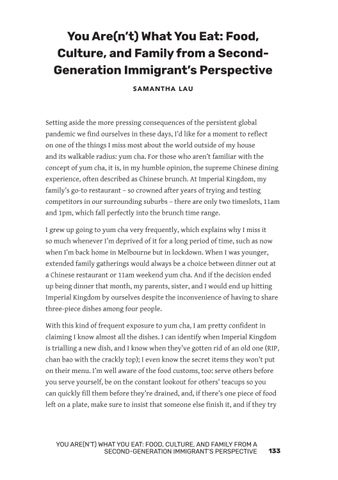You Are(n’t) What You Eat: Food, Culture, and Family from a SecondGeneration Immigrant’s Perspective SA M A NTHA L A U
Setting aside the more pressing consequences of the persistent global pandemic we find ourselves in these days, I’d like for a moment to reflect on one of the things I miss most about the world outside of my house and its walkable radius: yum cha. For those who aren’t familiar with the concept of yum cha, it is, in my humble opinion, the supreme Chinese dining experience, often described as Chinese brunch. At Imperial Kingdom, my family’s go-to restaurant – so crowned after years of trying and testing competitors in our surrounding suburbs – there are only two timeslots, 11am and 1pm, which fall perfectly into the brunch time range. I grew up going to yum cha very frequently, which explains why I miss it so much whenever I’m deprived of it for a long period of time, such as now when I’m back home in Melbourne but in lockdown. When I was younger, extended family gatherings would always be a choice between dinner out at a Chinese restaurant or 11am weekend yum cha. And if the decision ended up being dinner that month, my parents, sister, and I would end up hitting Imperial Kingdom by ourselves despite the inconvenience of having to share three-piece dishes among four people. With this kind of frequent exposure to yum cha, I am pretty confident in claiming I know almost all the dishes. I can identify when Imperial Kingdom is trialling a new dish, and I know when they’ve gotten rid of an old one (RIP, chan bao with the crackly top); I even know the secret items they won’t put on their menu. I’m well aware of the food customs, too: serve others before you serve yourself, be on the constant lookout for others’ teacups so you can quickly fill them before they’re drained, and, if there’s one piece of food left on a plate, make sure to insist that someone else finish it, and if they try
YOU ARE(N’T) WHAT YOU EAT: FOOD, CULTURE, AND FAMILY FROM A SECOND-GENERATION IMMIGRANT’S PERSPECTIVE
133






